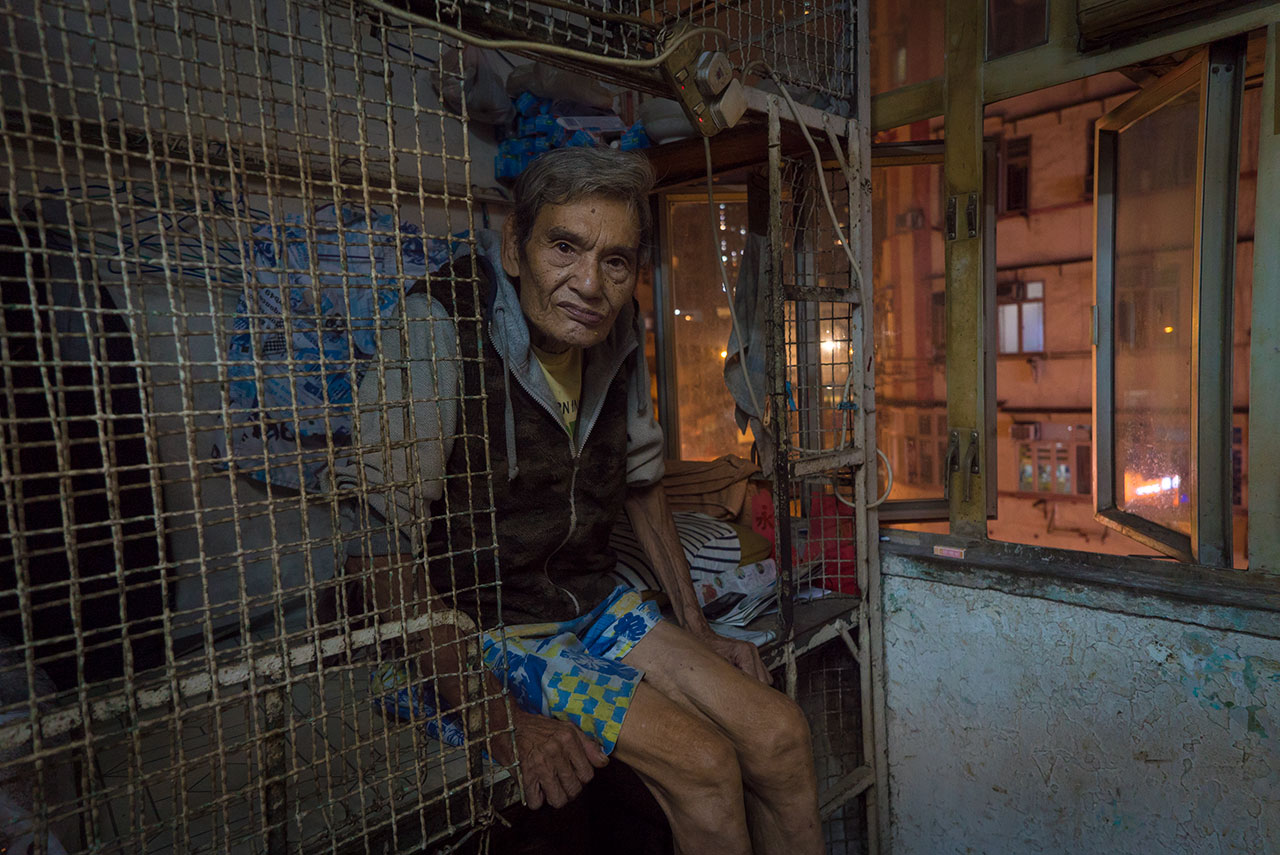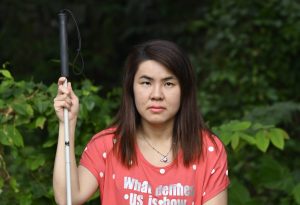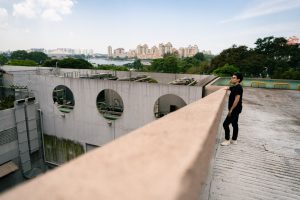As we ascend the dimly lit staircase to the apartment, my translator, photographer and I are overwhelmed by the smell of cigarette butts and days-old garbage. Empty cartons of food, banana peels, plastic bottles and beer cans are strewn all over the landings. Most apartment doors are padlocked, with Chinese signs for good luck displayed on the outside.
Just as the outside of these apartments are not out of the ordinary, the building’s plain and monochrome exterior is no different from the hundreds of apartment blocks in the densely populated Yau Tsim Mong district. On the street below, passersby remain oblivious to fact that in one of its 500 sq ft (46 sq metre) apartments, 30 residents live in confined, individually-built plywood bunkbeds, complete with its own wooden door or wire cage.
However, the residents in these apartments are some of the city’s poorest and most vulnerable – retirees, drug addicts, illegal immigrants, individuals with physical and mental illness – who are unable to keep up with the extortionate cost of housing in Hong Kong.
Hong Kong is home to more millionaires per square mile than any other city in the world. But for all its worship of wealth and money, behind its capitalist success is a city plagued with extreme poverty.
In many ways, their home is a metaphor for their lives: trapped in a purgatory behind wooden doors or wire fences, there is no hope of escaping any time soon, and they continue to lead a life of lonely torment. Most of them feel hopeless, deranged from the monotony of living in a wooden coffin, awaiting the day they are going to be placed inside a real one.
Despite this, the residents invite me into their homes with open arms, eager to show me how they live.

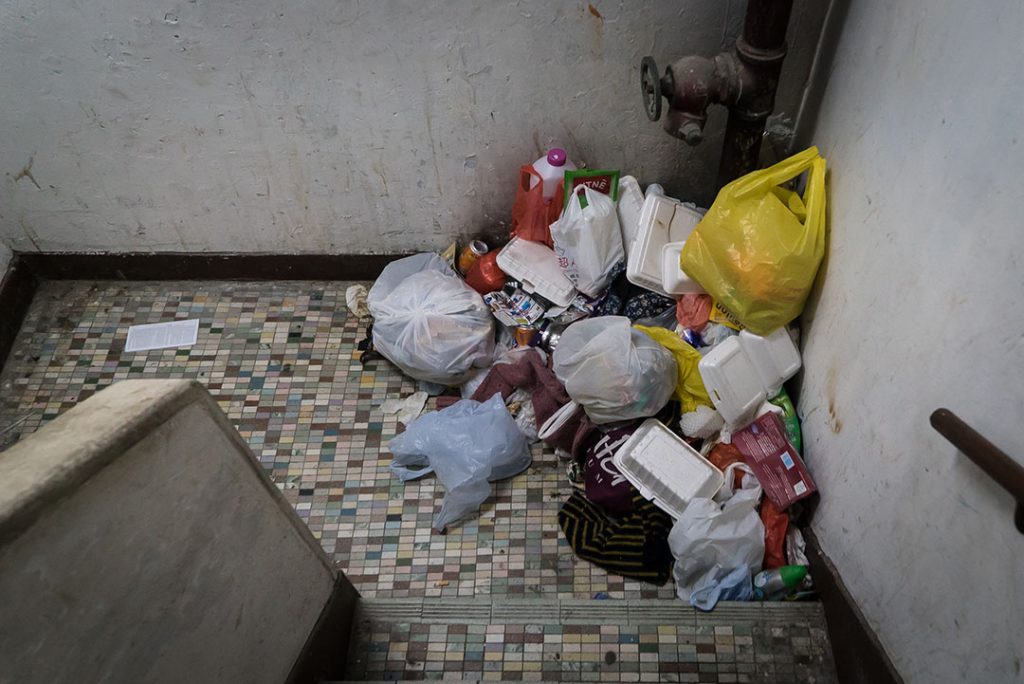
We reach the sixth floor of the first building and knock on the door, but before I can even catch my breath, we are greeted by a woman in her mid-fifties. She seems somewhat shocked to see us but gives us a hearty welcome. “Come in,” she exclaims, “Don’t be shy!”
Akin to an overnight sleeper train, the tiny apartment has a narrow passageway, with bunk beds on each side. Cramped, with no natural light, each bed is approximately 60cm wide and 170cm long, leaving only enough space for one to sit up. At the end of the corridor, there is a single shower and toilet.
Behind the welcoming woman, a young boy peers curiously through his sliding door. On the bunk bed above him, an elderly man does the same, but fleetingly slides his door shut before we can get a closer look.
Residents try to make their individual coffin-beds as homey as possible by hanging up posters and pictures, and placing a small TV at the foot of their bed. When they leave, they shut and lock their doors to protect their belongings, a lifetime’s worth of memorabilia. Some of their most prized possessions come in the form of a pair of shoes, or a football jersey with their favourite player’s name.
Simon
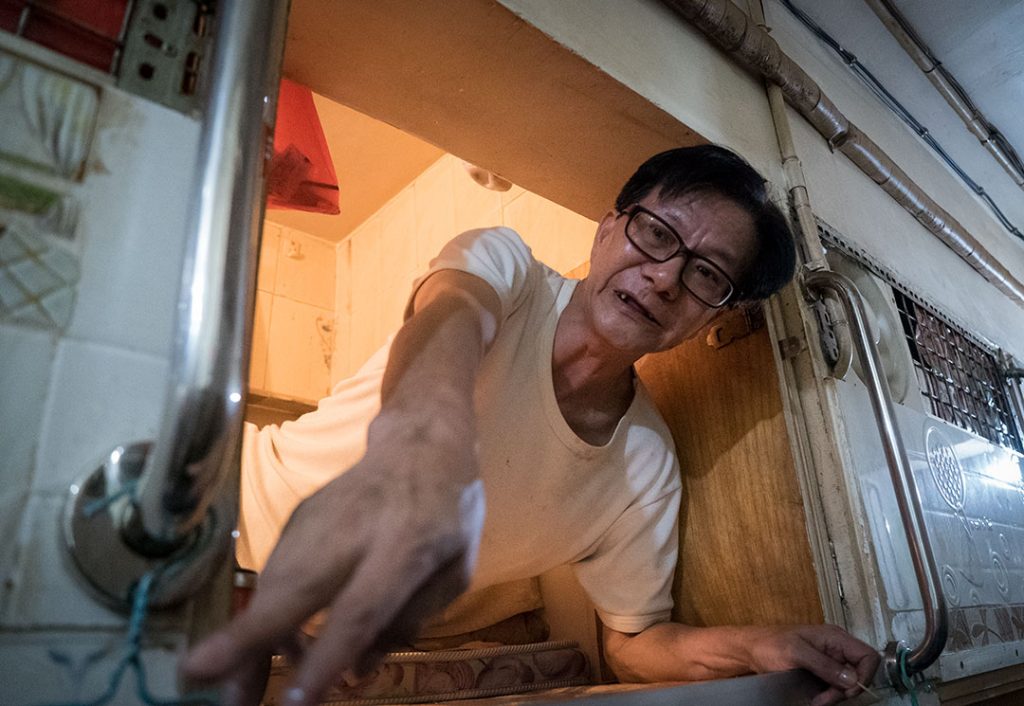
Simon invites me ‘up’ to his house. He has been living here for nearly eight years. Retired and unemployed, he has given up any hope of living in public housing which has a five-year waiting period. Over 100,000 families are competing to get a much sought-after spot in one of the estates. It is a game of chance, and only a lucky few are selected to move in. There is a hierarchy as well; the government’s calculation excludes several types of people, including single people under 65, who could be forced to wait for over a decade. Simon, unfortunately, falls under this category.
“This is where I live,” says Simon, gesturing to the mattress and his belongings. The big grin slowly escapes his face as he sits inside his 12 sq ft (1.1 sq metre) home.
Almost everyone living in the apartment is weak and extremely thin. Simon is no exception. The toll of his suffering is clearly visible from the lines across his face and the callouses on his skin. The few teeth that he has left are stained from years of – what I assume to be – smoking, and a lack of dental hygiene.
“How much were your shoes?” he asks, laughing, before excitedly showing off his Adidas sneakers. “These were HK$600 (S$105),” he continues, with a proud smirk, and carefully places them behind the ladder to his bed.
Simon dodges questions about his family. In a haste, he tells me that they live elsewhere.
He receives HK$5,000 (S$867) from the government each month. HK$1,900 (S$330) is used on rent; the rest does not even get him to the end of the month.
The monthly rent for one bunk ranges from HK$1,800 (S$312) to as much as HK$2,500 (S$433), according to the Society for Community Organisation (SoCo), an NGO that provides help to Hong Kong’s poorest.
Three beds down, a young woman gestures me over.
Choi Wan

Without a visa and unable to work, she relies on welfare from the government and donations from friends and NGOs to support her.
“My previous rent was HK$3,000 (S$520). That was too expensive, so I came here,” she says. “I get HK$1,800 (S$312) from the government, and my friends give me HK$100 (S$17) extra to help me pay my rent. Many volunteers come and donate food. I don’t know how I would survive otherwise.”
Without being presumptuous, her coloured contacts, long, false eyelashes and dress are a giveaway to the type of work she might feel obliged to take on.
We ask if we can take her photo. Choi Wan primps her hair, but at the last minute, decides to face the other way.
As we leave, the woman who opened the door for us smiles and tells us to come again, but warns us to call her beforehand.
“If the landlord is here when you come, he will get very angry,” she says, and shuts the door.
According to the Census and Statistics Department, there are nearly 200,000 people living in some form of subdivided apartment in Hong Kong. 18% are younger than 15, but SoCo say the number is likely to be much higher, as many illegal apartments are left unaccounted for.
Many argue that the government and property magnates from Mainland China are to blame for the current housing crisis. The Hong Kong government posted a HK$92bn surplus last year, and has fiscal reserves worth HK$860bn. Yet the city’s levels of disparities in development is shocking. The poorest 10% earn, on average, HK$2,600 (S$450) a month.
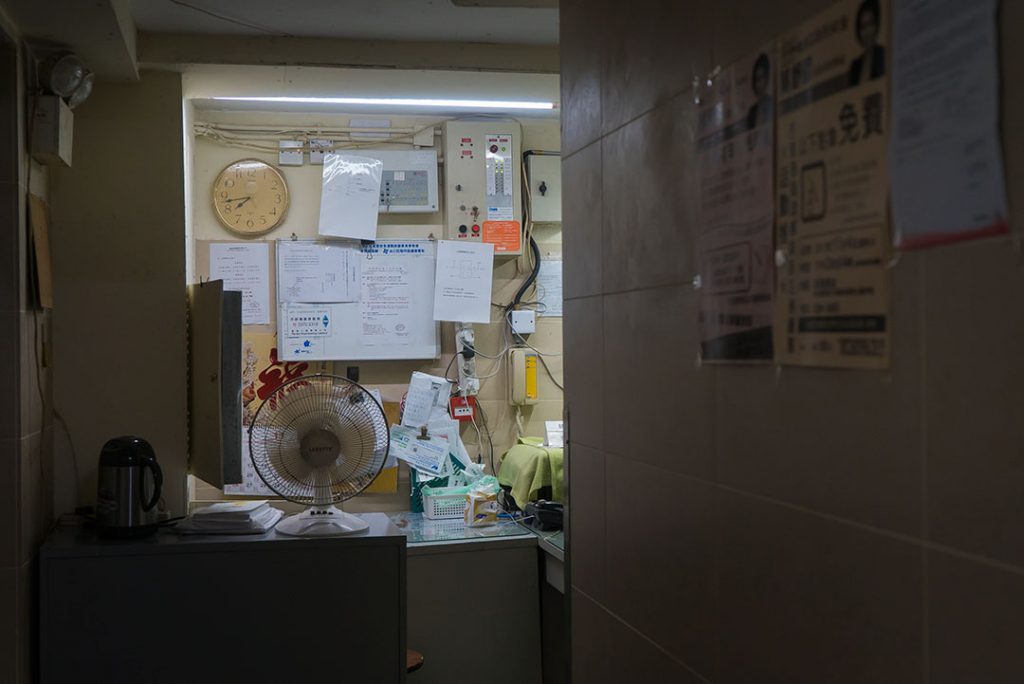
When we arrive, we are greeted by a security guard and a well-lit lobby. The building even has a lift, a positive upgrade from the previous one.
Each floor has a long, narrow corridor, housing approximately 25 apartments on each side of it.
We enter the second apartment through two heavy, metal doors, and I am immediately welcomed by the strong, musty smell of mold and beer. The flat’s dark corridor reminds me of the kind of alleyway you would not want to walk through late at night, but the residents make me feel so at ease, it is easy to forget where you are.
Twenty men live in this 300 sq ft (28 sq metre) space. The thin plywood walls between beds do little to block noise. I can hear every line of dialogue from the movie playing on one of the residents’ TV; the pitter patter of someone using the singular shower; the rustling of pages from a newspaper, and a frequent, aggressive cough.
As we make our way down the narrow corridor, a loud voice echoes through the space, “I want! Give me please!”
Michael
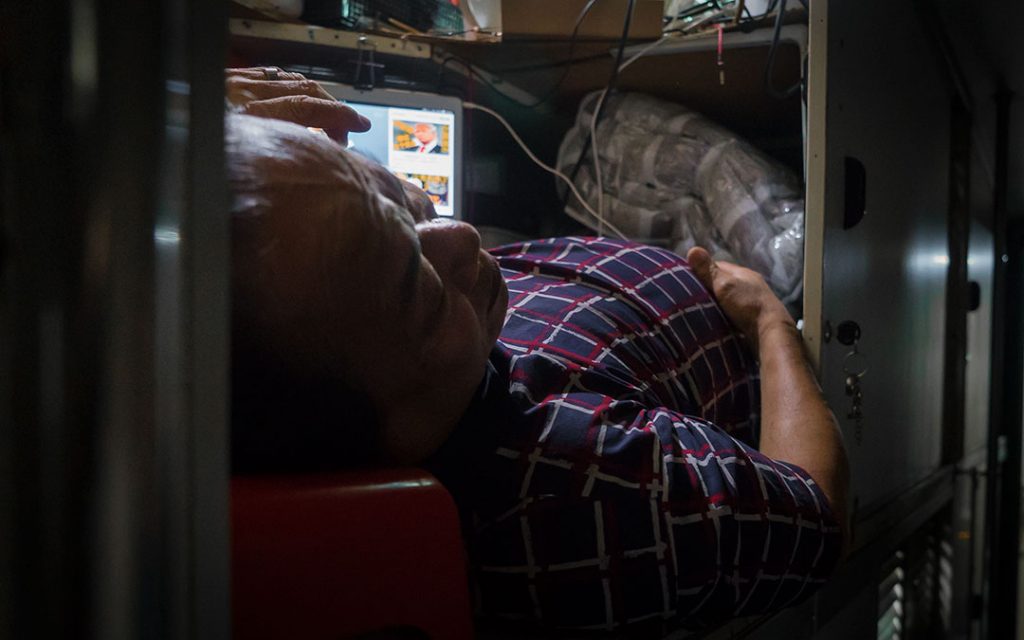
“I am 70 years old now, no one will employ me,” he says, “I used to be a security guard.”
If the apartment were a classroom, Michael would be the class clown. Constantly making jokes and taking jibes at the other residents, his fun-loving and vibrant personality does not go unnoticed.
“My favourite food is rice. I like char siu fan (BBQ pork and rice). I know a place you can get it for HK$20,” Michael claims, eyes glued to his TV. He – like Simon – also gets HK$5000 from the government. “But the money always runs out,” he tells me, with a half-smile.
I ask Michael about a cluster of dark, red streaks – I assume they are blood stains – in the corner of his wall. “Oh these are bed bugs. I probably kill one every week,” he says to me, unfazed, eyes still glued to his TV. The itchy, red spots on some of the other residents’ arms make sense to me now.
Sam

Sam, at a stretch, is in his early forties, still in the prime of his work life. I walk over and start speaking to him. He tells me he has been living in this apartment for a little over two years. “I used to be a security guard too, but I got very sick,” he says, “My liver has a lot of problems and I cannot work anymore. No one will hire someone who falls sick all the time.”
Smoking a cigarette as he sits on his bed, Sam tells me that he spends most of his days in the park down the road. “It’s nice there and there is fresh air,” he adds, “It’s better than being inside all day. Then I come home and sleep.”
Sam receives some money from the government every month, but nowhere near as much as Simon and Michael. He relies on donations from SoCo and other organizations, as well as the kindness of his friends.
It appears that the other residents act as a sort-of father figure to Sam. There is a caring undertone in the voice that they use to speak with him.
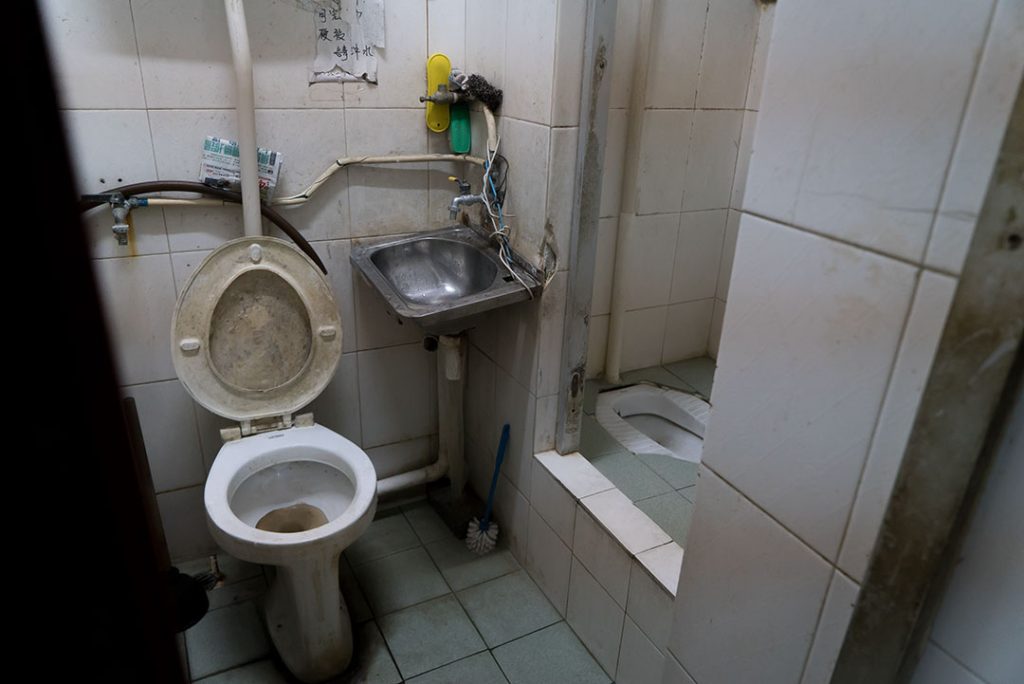
The last home we visit is one of the few that still exist today.
Making our way through the wet markets of Mong Kok, we step over – or rather, try to dodge – fish bones, pools of blood, and squashed vegetables. I notice several small cages inside a butcher’s shop where a few chickens roam, ignorant of their potential fate. Little did we know that this sight would act as a haunting prelude to what we were about to witness.
Although the last apartment we visit has a significantly larger communal space, it is the most depressing of the three. It is home to five elderly men – all of whom are in their 70s and 80s – with severe health issues. Here, the cages are also stacked up one upon the other.
On the right is a dilapidated toilet and bathroom with broken fixtures and no hot water. On the left, a statue of a Chinese legendary character sits perched on a wooden mantle. A symbol of hope, the deity is worshipped for wealth and protection. Sadly, neither has been bestowed upon the people living in this caged-home. Yet each day, incense sticks are lit by the residents and placed before him.
At present, there are only five tenants living here, but a handful of uninhabited bunks compel me to remember the ghosts of previous cage-dwellers, whose old beds are now used as a storage facilities.
Bottles of shampoo, shower gel and soap make up the bulk of their items. Washed jeans, shirts and undergarments are hung up on the wire mesh to dry, whilst extra blankets and bedding are kept folded on another unused bunk.
The quandary of Hong Kong’s cage-dwellers is well known in the city. In fact, recently, a hostel styled its dormitory as a hipster, caged ‘coffin’-bed hybrid of sorts, taking inspiration from the city’s caged-homes. Calling themselves “authentically Hong Kong”, they have obviously received backlash. But the existence of such a facility speaks volumes for the complacency that has developed in the city. It comes complete with clean mattresses, a pillow to sleep on, and modern décor (for the authentic experience, of course).
Mr. Leung and friends
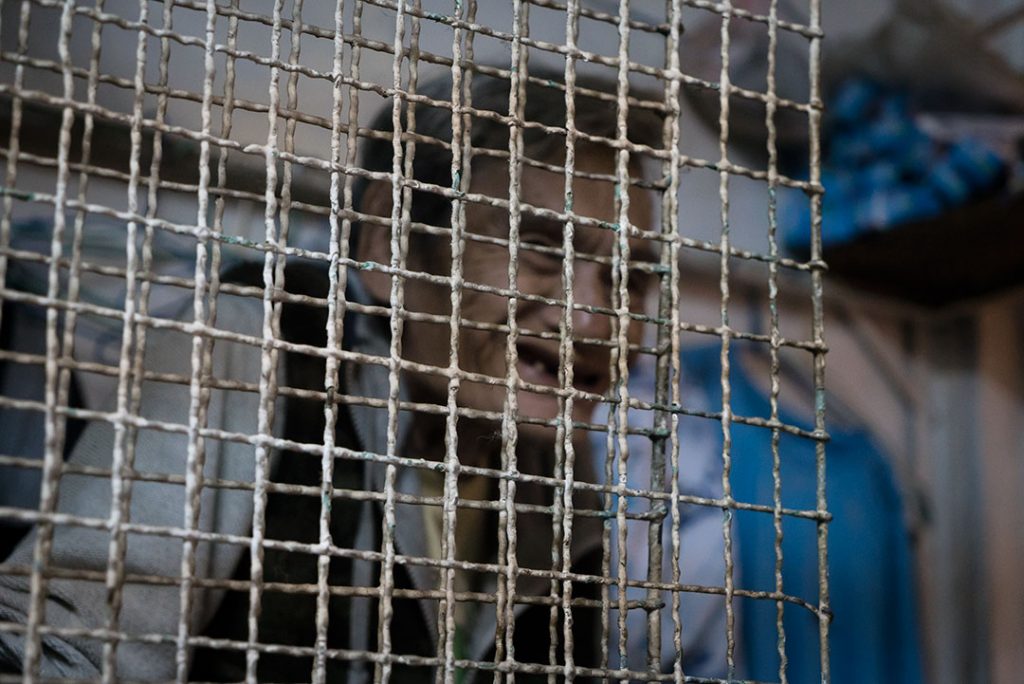
Frail and aged, I notice how his skeletal frame struggles to even climb up to his bed. He tells me that he doesn’t have any family and never got married. I wonder how different his life would be if he had the support of a wife and children.
“I like to go to the park to spend my days,” he says, “I sit there and read.”
On the bunk below him, a man sleeps, unresponsive to the noise and chaos from the group of volunteers. He holds on tightly to the supermarket voucher we give him, but continues to sleep, his head supported by a Tupperware box.
Mr. Leung asks us to take his photo, and graciously smiles for the camera. Through the crack in the window behind him, a high-rise apartment block stands tall. A sad juxtaposition; one that Mr. Leung undoubtedly sees every morning when he wakes up.
As we make our way out, a quiet man sitting at the table waves us over. He folds his newspaper and puts it to one side. He tells us one last story.
Just this year, he fell gravely ill and could not sleep or eat for weeks. He refused to go to a hospital for treatment and sat at his desk all day. I ask him why he didn’t get help.
“I just want to die,” was the answer.
I never got a chance to ask him his name, but his words have stayed with me.
I wave Mr. Leung and his friends goodbye. “Thank you,” they say, with sullen eyes.
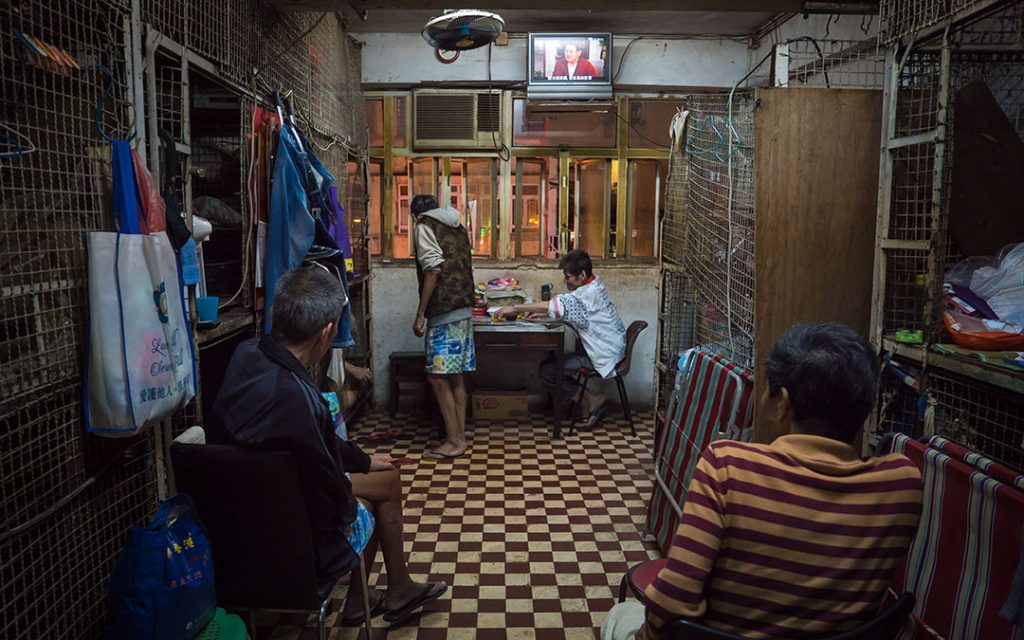
However, the silence does not last very long.
“I’m hungry. Where should we have dinner?” one of the volunteers asks a friend.
“If we take a taxi to Elements, it will take five minutes,” was the answer. (Elements is a luxury shopping mall, also home to many expensive restaurants and bars.)
In a matter of minutes, the suffering of those we just visited is forgotten about.
I am left struggling to understand how over 100,000 people live in such squalor, when merely a few feet away, others are visiting a high-end shopping mall for a quick trip to a favourite restaurant. Simon, Choi Wan, Michael, Sam and Mr. Leung might represent the overlooked and neglected members of our society, but their stories and struggles to live through such unbearable adversity should be anything but discounted for.
